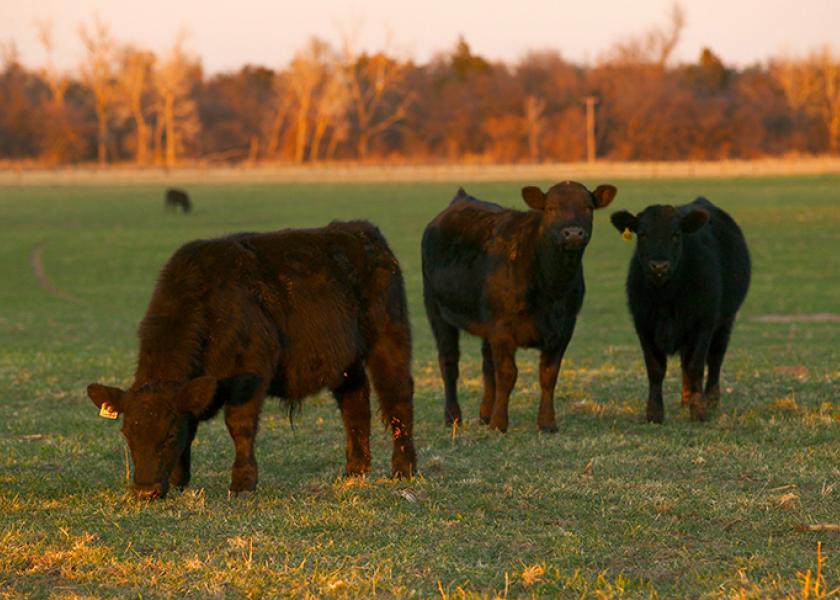Supplementation Options when Wheat Pasture is Short

Prospects for wheat pasture started off in good shape this fall with many areas getting late summer rains. However, most of the wheat grazing areas did not get adequate rains to push the emergence and growth of wheat pasture for most of the month of September and October. Most of the region got nice rains that will likely drive enough forage production on early planted wheat for grazing by mid-November or early December. Later planted wheat or wheat that had not emerged from earlier plantings will probably be severely delayed even with the latest round of precipitation in October.
What can we do to sustain stocking rates that support at least approaching our normal levels of production?
Setting stocking rates on wheat pasture in the fall and winter has large impacts on performance of growing calves and can have large influences on productivity of pastures during the spring. We have found that the maximum ADG could be expected at 5.0 pounds of forage dry matter per pound of initial calf bodyweight and ADG and if the initial forage allowance is restricted to 2.4 lb forage DM/lb initial calf bodyweight we can still see adequate performance of around 2 lbs/day.
If forage allowance falls below 2 pounds of forage dry matter per pound of calf bodyweight, supplementation should be considered. If we use an average of about 200 pounds of forage per inch in plant height, a good stand of wheat that is 4 inches tall (800 pounds of forage dry matter per acre) will require stocking rates of about 2.5 to 3 acres per 500-pound steer for adequate season long performance.
Research from the OSU Wheat Pasture Research Unit at Marshall showed that providing a concentrate supplement (based on either corn or a soyhull/wheat middling blend) containing monensin at 0.65 to 0.75% of body weight (for example, 4 pounds per day for a 533-pound steer) increased potential stocking rate by 33% and weight gains by 0.3 pounds per day. This supplementation program can also be used to “stretch” wheat forage when pastures were 60 to 80% of normal, allowing for “normal” stocking rates.
Recently, we stocked steers on wheat pastures at forage allowances of either 1.5 or 3 pounds of forage DM/pound of steer bodyweight with or without 3.3 pounds per day of a wheat middling/soyhull feed blend. Steers on the higher forage allowance (3.0 lbs forage DM/ lb steer bodyweight) with supplementation gained the most (3.8 lbs/day) while unsupplemented steers on the higher forage allowance gained 3.6 lbs/day. Supplementation increased gains more for steers at the lower forage allowance where gains of steers stocked at forage allowance of 1.5 lbs forage DM/lb steer bodyweight increased from 2.5 lbs/day to 3.2 lbs/day with supplementation.
Intake of low-quality roughages is not high enough to offset wheat forage intake and can reduce performance of growing calves. Research has shown that offering moderate to high quality roughages such as corn silage or sorghum silage or round bale silages can be used to replace short wheat pasture or double stocking rates on wheat pastures. Early research showed that feeding corn or sorghum silage daily to calves on wheat pasture allowed stocking rates to be increased by up to 2X without reducing steer performance.
We repeated this research by offering bermudagrass round bale silage to steers stocked at 1, 1.5 or 2 steers per acre with forage allowances going from 2.9 to 1.2 lbs forage/lb of bodyweight. Offering round bale silage at the lowest stocking rate actually increased gains compared with steers at the same stocking rate without silage (3.15 vs 2.79 lbs/day). As we increased stocking rate, average daily gain decreased, but total gain per acre increased by 52%.
There are some feeding options available to us when the economic conditions are right, but forage conditions are lacking. Feeding either limited concentrate supplement or moderate quality roughage during the fall can increase production stability and thus improve economic stability of the wheat stocker enterprise. There does not appear to be economic advantage of feeding stockers grazing spring wheat when producers decide to forgo wheat grain harvest and steers graze out the wheat crop.







